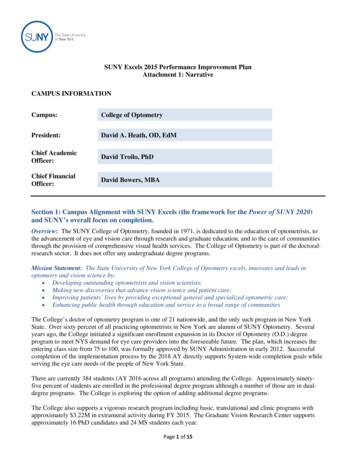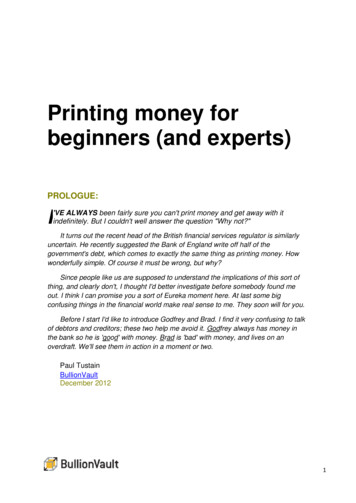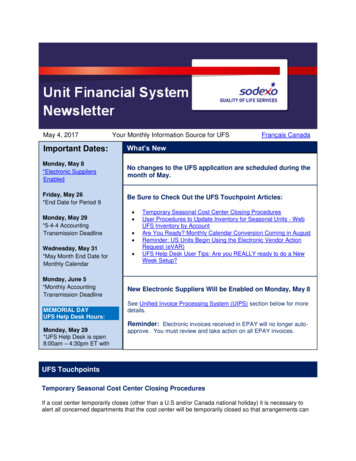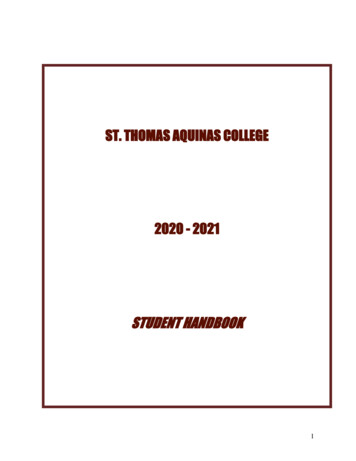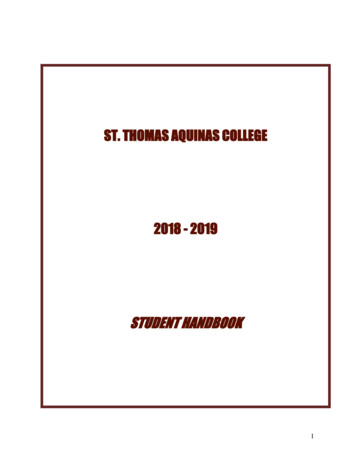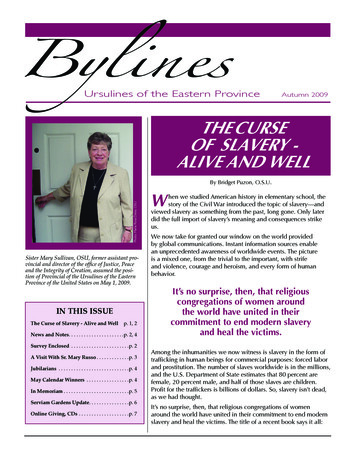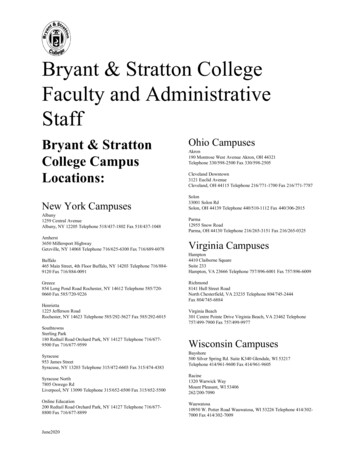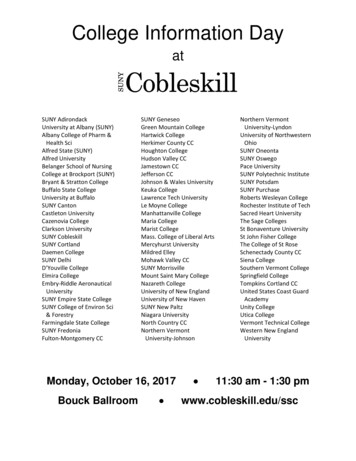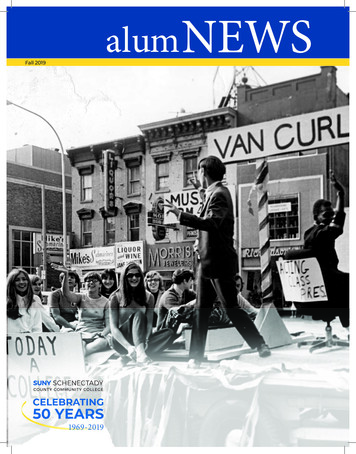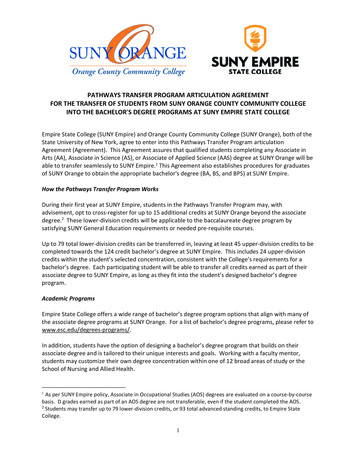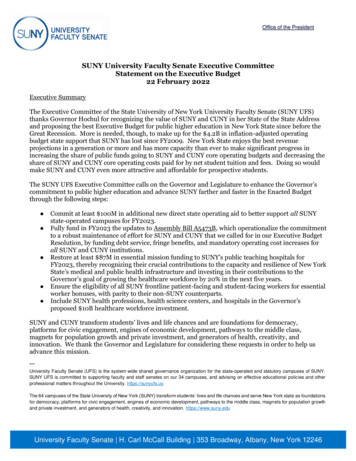
Transcription
Office of the PresidentSUNY University Faculty Senate Executive CommitteeStatement on the Executive Budget22 February 2022Executive SummaryThe Executive Committee of the State University of New York University Faculty Senate (SUNY UFS)thanks Governor Hochul for recognizing the value of SUNY and CUNY in her State of the State Addressand proposing the best Executive Budget for public higher education in New York State since before theGreat Recession. More is needed, though, to make up for the 4.2B in inflation-adjusted operatingbudget state support that SUNY has lost since FY2009. New York State enjoys the best revenueprojections in a generation or more and has more capacity than ever to make significant progress inincreasing the share of public funds going to SUNY and CUNY core operating budgets and decreasing theshare of SUNY and CUNY core operating costs paid for by net student tuition and fees. Doing so wouldmake SUNY and CUNY even more attractive and affordable for prospective students.The SUNY UFS Executive Committee calls on the Governor and Legislature to enhance the Governor’scommitment to public higher education and advance SUNY farther and faster in the Enacted Budgetthrough the following steps: Commit at least 100M in additional new direct state operating aid to better support all SUNYstate-operated campuses for FY2023.Fully fund in FY2023 the updates to Assembly Bill A5473B, which operationalize the commitmentto a robust maintenance of effort for SUNY and CUNY that we called for in our Executive BudgetResolution, by funding debt service, fringe benefits, and mandatory operating cost increases forall SUNY and CUNY institutions.Restore at least 87M in essential mission funding to SUNY’s public teaching hospitals forFY2023, thereby recognizing their crucial contributions to the capacity and resilience of New YorkState’s medical and public health infrastructure and investing in their contributions to theGovernor’s goal of growing the healthcare workforce by 20% in the next five years.Ensure the eligibility of all SUNY frontline patient-facing and student-facing workers for essentialworker bonuses, with parity to their non-SUNY counterparts.Include SUNY health professions, health science centers, and hospitals in the Governor’sproposed 10B healthcare workforce investment.SUNY and CUNY transform students’ lives and life chances and are foundations for democracy,platforms for civic engagement, engines of economic development, pathways to the middle class,magnets for population growth and private investment, and generators of health, creativity, andinnovation. We thank the Governor and Legislature for considering these requests in order to help usadvance this mission.***University Faculty Senate (UFS) is the system-wide shared governance organization for the state-operated and statutory campuses of SUNY.SUNY UFS is committed to supporting faculty and staff senates on our 34 campuses, and advising on effective educational policies and otherprofessional matters throughout the University. https://sunyufs.usThe 64 campuses of the State University of New York (SUNY) transform students’ lives and life chances and serve New York state as foundationsfor democracy, platforms for civic engagement, engines of economic development, pathways to the middle class, magnets for population growthand private investment, and generators of health, creativity, and innovation. https://www.suny.eduUniversity Faculty Senate H. Carl McCall Building 353 Broadway, Albany, New York 12246
Full StatementThe Executive Committee of the State University of New York University Faculty Senate (SUNYUFS) thanks Governor Hochul for speaking eloquently in her State of the State Address aboutthe power of education to change lives and transform families, “across generations”; forcharacterizing SUNY and CUNY as “engines of social mobility” with “untapped potential”; andfor “outlining a vision to make SUNY the best statewide public higher education system in thenation.”SUNY UFS supports Governor Hochul’s goals from her State of the State Book to “recruit andretain top faculty and staff” at SUNY, “significantly diversify the SUNY workforce,” and increase“the number of full-time faculty of color” at SUNY through “competitive salaries and benefitsand significant investments in professional development, technology, infrastructure,fellowships, and learning labs,” as well as improve “faculty compensation and faculty diversity”at university centers. The UFS agrees with Governor Hochul that it will take a diverse andequitably supported faculty and staff to plan and implement her proposals to supportapprenticeships in high-growth industries, targeting underrepresented groups such as womenand people of color; create an Empire State Teacher Residency Program that “will prioritizediversity among teacher residents and partnering mentors”; fund new cohorts of the MasterTeacher Program; “connect SUNY and CUNY student volunteers with local nonprofit partners tofill critical community needs identified by local stakeholders”; increase the number of paidinternships available to SUNY students; and help five additional SUNY campuses becomefederally designated as Minority-Serving Institutions.The SUNY UFS Executive Committee is encouraged by evidence in the Executive BudgetBriefing Book that Governor Hochul has considered UFS’s recommendations and rationalessupporting the call in our Executive Budget Resolution for New York State to become a nationalleader in “sustainably and equitably supporting and advancing SUNY and CUNY’s core academicmissions” and in “investing direct state aid in SUNY and CUNY’s core operating budgets.” TheExecutive Committee finds much to applaud in the Executive Budget, including proposals toincrease operating funds for SUNY and CUNY, increase support for educational opportunityprograms and centers, expand eligibility for the Tuition Assistance Program (TAP), increaseinvestments in and access to SUNY child care centers, and immediately and permanentlyeliminate the TAP Gap and the Excelsior Gap. We enthusiastically support these aspects ofGovernor Hochul’s vision and goals for SUNY; together, they represent a long-awaited departurefrom over two decades of nearly uninterrupted balancing of New York State budgets in partthrough inflation-adjusted cuts to SUNY’s campuses, public teaching hospitals, and students’learning conditions.Governor Hochul’s Executive Budget proposal thus represents a significant step in the rightdirection for SUNY. However, given the scale of the substantial declines in direct state aid forthe SUNY core operating budget since the Great Recession—from the peak of FY2009, thirteenyears of combined reductions total over 4.2B, in 2020 dollars—we fear that the proposedExecutive Budget does not support campuses facing fiscal challenges escalated by the pandemicor advance SUNY far or fast enough. Adjusted for inflation, state support for SUNY coreoperations in FY2021 was about 61% of the level from FY2009—a reduction of 38.6% (see Table1, below). As a result, SUNY’s campuses have been making repeated and often substantial cuts2
even while burning through reserve funds. Tuition increases have shifted costs onto studentsand their families, yet have covered only a small portion of the reductions. While all campuseshave been harmed, the impact on SUNY’s comprehensive colleges and colleges ofagriculture/technology has been particularly acute. In the past two years alone, the COVID-19pandemic imposed new risks, costs, stresses, and responsibilities on their students, staff, faculty,and leaders, with especially heavy burdens on their frontline patient-facing and student-facingworkers. Even the significant federal pandemic relief funds that have been made available toSUNY and CUNY campuses provide only short-term offsets to severe drops in recurring statesupport.As of this writing, New York State enjoys the best revenue projections in a generation or more.The state has more capacity than ever to make much more progress in increasing the share ofpublic funds going to SUNY and CUNY core operating budgets, decreasing the share of SUNYand CUNY core operating costs paid for by net student tuition and fees, and thereby makingSUNY and CUNY even more attractive and affordable for prospective students.Hence, we call on the Governor and the Legislature to incorporate into the final Enacted Budgetthe following priorities: Commit at least 100M in additional new direct state operating aid to better support allSUNY state-operated campuses for FY2023. Fully fund in FY2023 the updates to Assembly Bill A5473B, which operationalize thecommitment to a robust maintenance of effort for SUNY and CUNY that we called for inour Executive Budget Resolution by funding debt service, fringe benefits, and mandatoryoperating cost increases for all SUNY and CUNY institutions. Restore at least 87M in essential mission funding to SUNY’s public teaching hospitalsfor FY2023, thereby recognizing their crucial contributions to the capacity and resilienceof New York State’s medical and public health infrastructure and investing in theircontributions to the Governor’s goal of growing the healthcare workforce by 20% in thenext five years. Ensure the eligibility of all SUNY frontline patient-facing and student-facing workers foressential worker bonuses, with parity to their non-SUNY counterparts. Include SUNY health professions, health science centers, and hospitals in the 10Bhealthcare workforce investment.The increase in additional new direct state operating aid to SUNY’s state-operated campuses,combined with the commitment to a robust maintenance of effort, would help New York Stateaddress two resolutions from the UFS’s Winter 2022 Plenary, which request that the FY2023budget: Includes funds specifically allocated to recruit, retain, and mentor faculty of color inSUNY that are sufficient to significantly and rapidly close the gap between the proportionof SUNY students of color relative to the entire SUNY student body and the proportion ofSUNY faculty of color relative to the overall SUNY faculty. Creates a pool of funding and appropriate resources for hiring full-time and/or tenuretrack faculty with expertise in teaching courses that fulfill the learning outcomes of the3
new SUNY General Education Framework category of Diversity: Equity, Inclusion, andSocial Justice on campuses that currently have little teaching expertise in this area.SUNY and CUNY transform students’ lives and life chances and are foundations for democracy,platforms for civic engagement, engines of economic development, pathways to the middle class,magnets for population growth and private investment, and generators of health, creativity, andinnovation. We thank the Governor and Legislature for considering these requests in order tohelp us advance this mission.***University Faculty Senate (UFS) is the system-wide shared governance organization for the state-operated and statutorycampuses of SUNY. SUNY UFS is committed to supporting faculty and staff senates on our 34 campuses, and advising oneffective educational policies and other professional matters throughout the University. https://sunyufs.usThe 64 campuses of the State University of New York (SUNY) transform students’ lives and life chances and serve New Yorkstate as foundations for democracy, platforms for civic engagement, engines of economic development, pathways to the middleclass, magnets for population growth and private investment, and generators of health, creativity, and innovation.https://www.suny.edu4
Table 1. State-Operated Campus Direct State Tax Support and Reduction in DirectState Tax Support from the 2008-09 Peak.The following table is drawn from a presentation by the SUNY Associate Vice Chancellor forFinance and Business. This table calculates the cumulative loss of state core operating supportsince 2008-09. The second column presents the nominal dollars; the third column presents thesame figures adjusted for inflation, in 2020 dollars. A one-time adjustment of about 200Mwas included in FY 2008-09 to cover contractual obligations; subtracting this amount from the2008-09 allocation establishes the baseline peak of state support in the third column. Thefourth column calculates the difference from that peak, and the final column calculates thereduction as a percentage of the peak year’s allocation. Whereas the combined reductionaverages about 28% over the 13-year period, the reduction in core state operating support in themost recent year is a 38.57% reduction from the peak.Table 1. State-Operated Campus Direct State Tax Support and Reductionin Direct State Tax Support from the 2008-09 Peak.Adjusted for 2020 Dollars / Does Not Reflect One-Time Deficit Reduction Plan (DRP) Actions in2020/21 ( K)Year2008-09 200M Adjustmentfor One-Time talAllocation inNominalDollars 1,034,000.0Allocation in2020 dollarsPercentageDifference from Reduction toPeakPeak's RealAllocation 1,352,460.5 1,152,460.5 861,062.6 785,982.2 704,044.9 707,998.8 404,998.9 715,618.9 712,687.4 707,998.9 707,998.9 707,998.9 707,998.9 707,998.9 707,998.9 9,140,387.1 1,083,587.6 971,554.7 863,969.9 852,240.1 840,456.5 838,274.8 813,541.6 793,877.3 784,374.0 761,376.8 742,563.2 721,708.7 707,998.9 10,775,524.1 68,872.9 180,905.8 288,490.6 300,220.4 312,004.0 314,185.7 338,918.9 358,583.2 368,086.5 391,083.7 409,897.3 430,751.8 444,461.6 1%31.11%31.94%33.93%35.57%37.38%38.57%28.08%Note: 2008/09 Includes 200.0M in One-Time Support for Collective Bargaining Costs. This is included in the base used forinflation adjustment.* 200M is removed from the 2008-09 entry in the third column to make the reduction calculations.5
Figure 1. State-Operated Campus Direct State Tax Support (Annual FundingAmounts in 2020 Dollars)The following figure is drawn from a presentation by the SUNY Associate Vice Chancellor forFinance and Business. This figure represents the same data as in Table 1 in graphical form, butdoes not include accumulated totals or percentage decreases.Table 2. NYS’s Rank among States on State Support (mostly tax revenues andlottery profits) in Constant Adjusted Dollars for Operating Expenses of PublicHigher Education per 1,000 Personal Income, per Capita, per Student FTE, asShare of Total State Revenues, and as Student Share (net tuition revenue as apercentage of total state revenue), 1980, 2001, 2008-2020We note that the Executive Budget Book accentuates the positive—New York State’s relativelyhigh ranking in direct state aid to public higher education operating expenses per full-timeequivalent student (student FTE) and fairly decent rank in student share (net tuition revenue asa percentage of total state revenue)—rather than its middle-of-the-pack status in direct state aidto public higher education operating expenses per capita and per 1,000 of personal income, orits extremely low ranking as a share of total state revenues. Therefore, we reproduce thefollowing table from our Executive Budget Resolution so that the Governor and Legislature mayconsider what SUNY and CUNY targets for the FY2023 budget would significantly move theneedle on metrics focused on state effort relative to state capacity. We can and should do better.New York is a large, wealthy state. We believe there should be more equity between public andprivate higher education in New York State.6
FY/ k)Studentshare(rank)19807.7 (34)313 (25)11,504 (9)5.7% (44)20% (16)20015.2 (44)297 (38)11,307 (20)3.8% (48)30% (23)2008 5.9 (36)352 (27)11,589 (15)3.9% (45)30% (13)2009 6.4 (36)367 (21)11,646 (8)4.2% (46)30% (12)20106.1 (34)358 (25)10,956 (9)4.2% (45)33% (15)20115.9 (30)359 (19)10,802 (7)4.0% (44)33% (12)20125.3 (29)329 (20)9,873 (8)3.6% (44)36% (9)20135.5 (29)337 (16)10,293 (8)3.6% (44)36% (9)20145.4 (29)341 (16)10,525 (7)3.6% (44)36% (9)20155.4 (30)349 (15)10,832 (7)3.6% (44)36% (10)20165.3 (31)349 (14)10,984 (6)3.5% (45)37% (10)20175.2 (34)355 (14)11,121 (7)3.7% (44)36% (11)20185.2 (28)363 (12)11,351 (6)3.5% (44)34% (9)20195.1 (30)366 (13)11,585 (6)34% (10)11,657 (8)34% (12)2020Source: State Higher Education Executive Officers Association (SHEEO)For more context, compare New York’s investments in public higher education to those ofCalifornia, Texas, Michigan, and Massachusetts, as well as the U.S. average.We close by observing that scoring the Executive Budget, One-House Budget, and EnactedBudget on the following metrics would allow for historical comparisons: SUNY’s share of NYS general fund NYS general fund share of SUNY's core operating budget Expected ratio of student share (net tuition) to state share (direct state aid) that coversSUNY’s core operating budget Appropriations of NYS general funds for SUNY operating expenses per student FTE per capita per 1K personal income7
SourcesGovernor Kathy Hochul. FY2023 Executive Budget Briefing x/book/briefingbook.pdf, January 2022.Governor Kathy Hochul. State of the State es/2022-01/2022StateoftheStateBook.pdf,January 2022.State University of New York University Faculty Senate. “Advancement of HistoricallyUnderrepresented Faculty.” 0-011 advancement of historically underrepresented faculty.pdf, January 2022.State University of New York University Faculty Senate. “Executive Budget 9/116933050/189-021 comm executive budget resolution.pdf, October 2021.State University of New York University Faculty Senate. “Successful Implementation of theSUNY General Education Category ‘Diversity: Equity, Inclusion, and Social 9/116933050/190-021 successful implementation of the suny general education diversity category.pdf,January 2022.8
The 64 campuses of the State University of New York (SUNY) transform students' lives and life chances and serve New York state as foundations . and CUNY core operating costs paid for by net student tuition and fees, and thereby making SUNY and CUNY even more attractive and affordable for prospective students. . SUNY state-operated .

